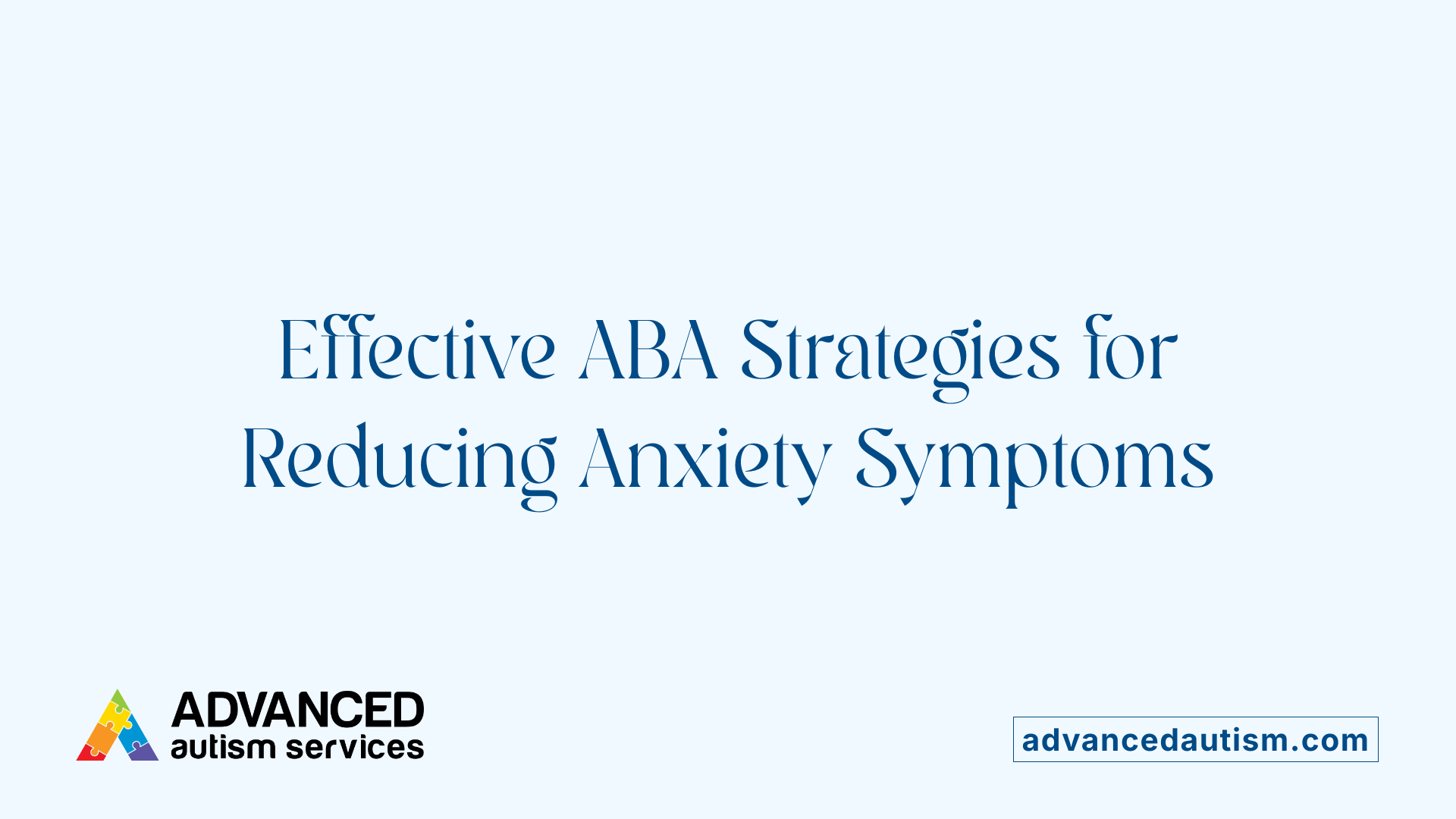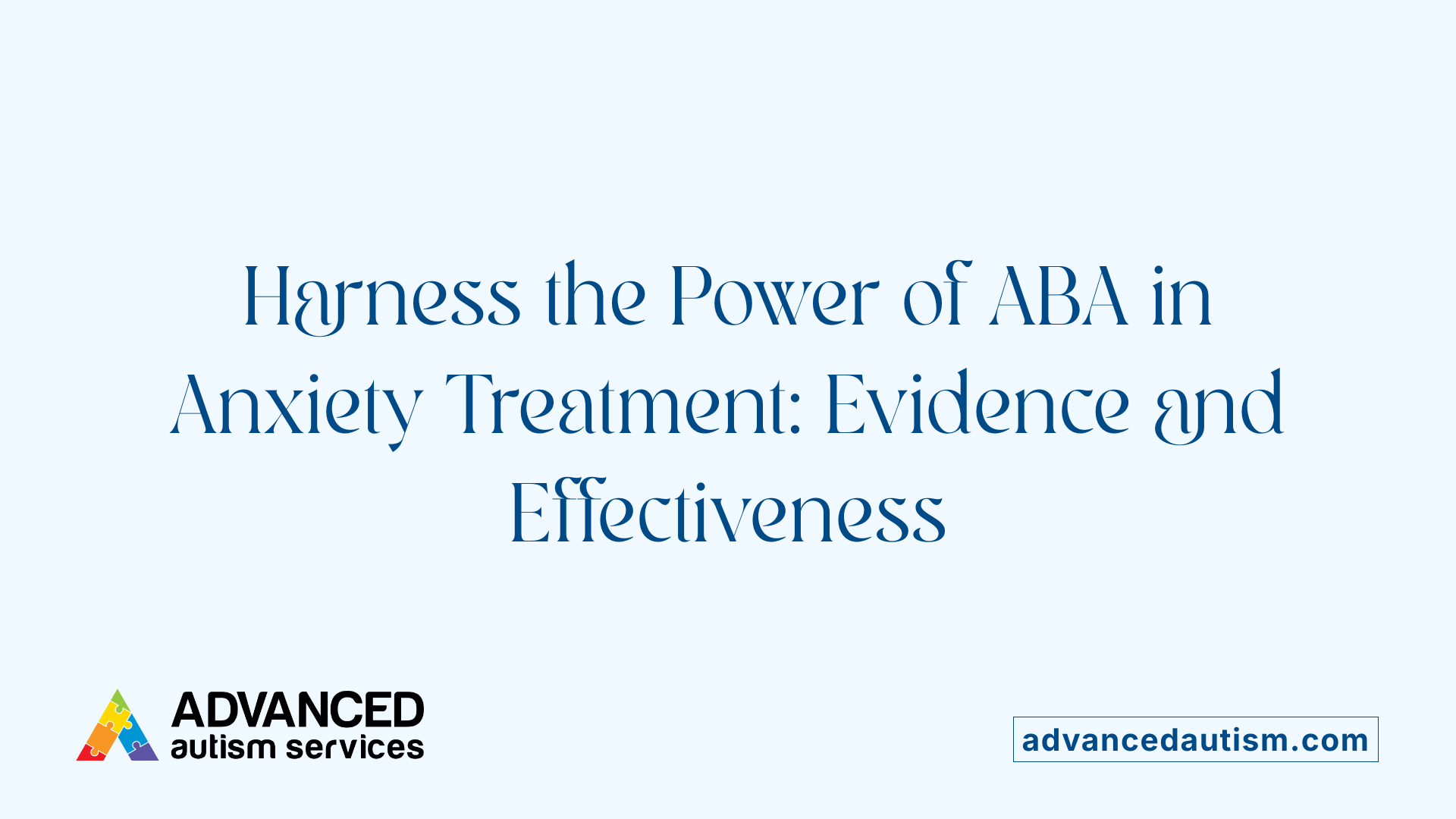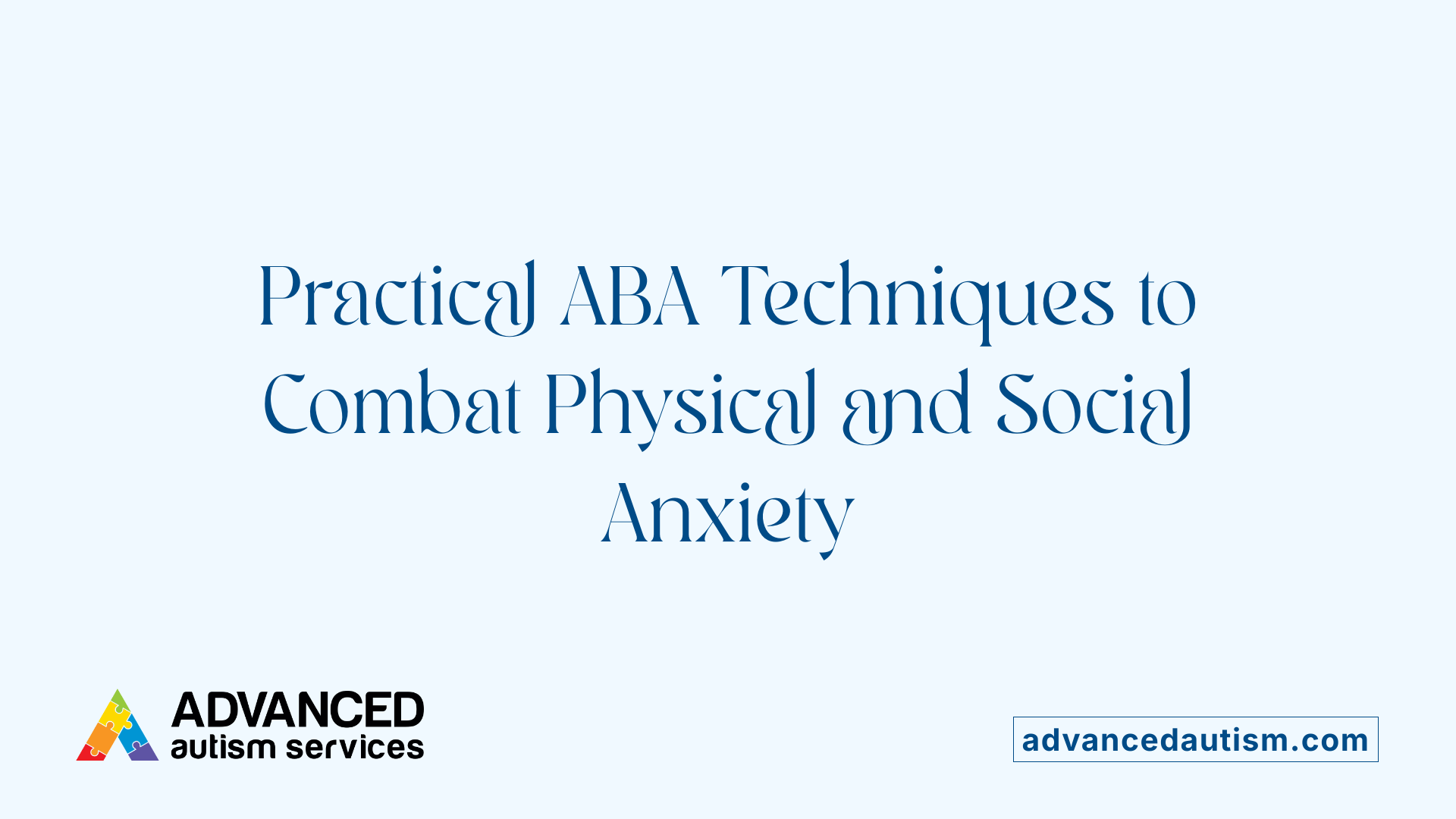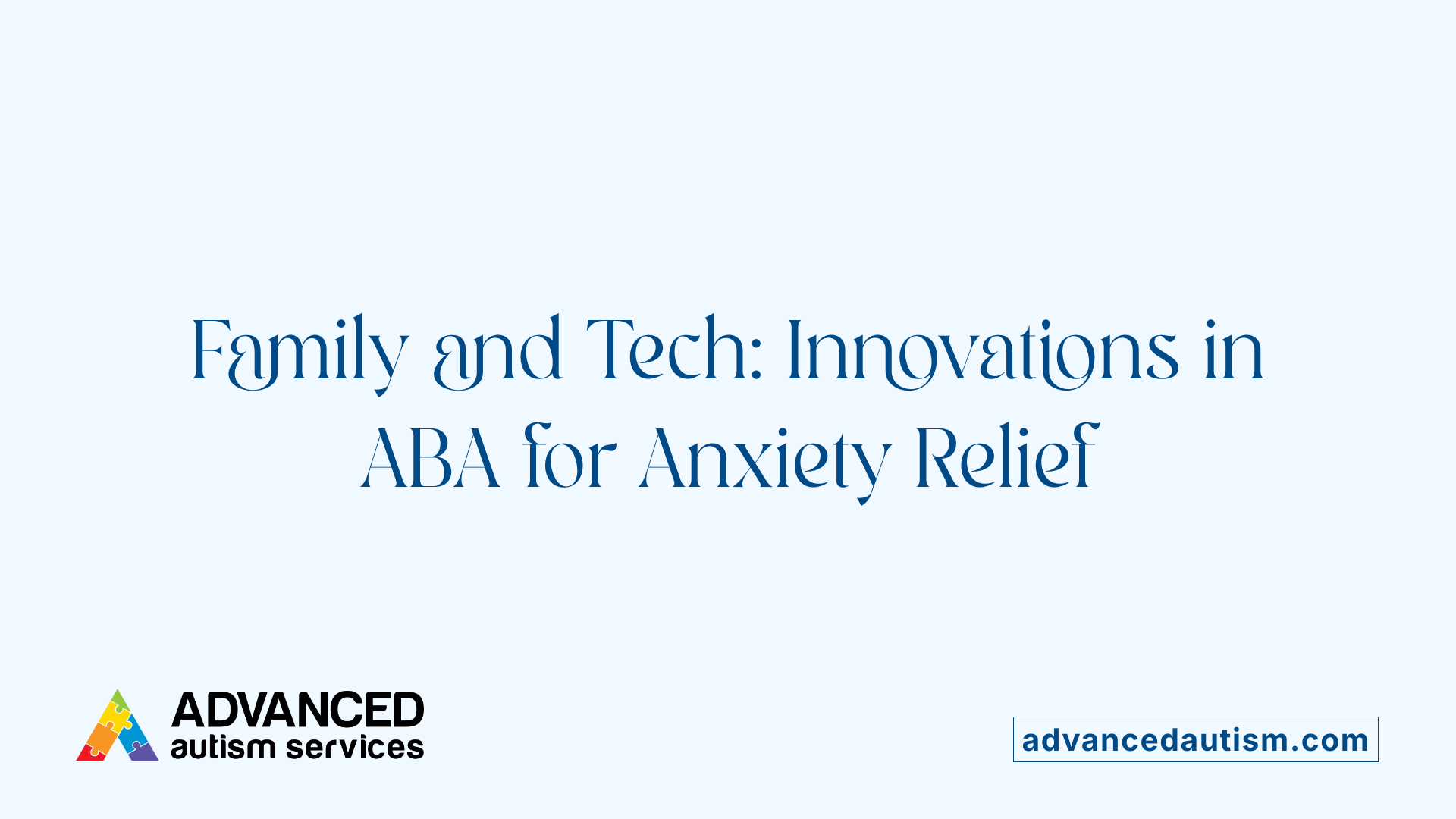Can ABA Therapy Help With Anxiety?
Exploring the Potential of ABA in Anxiety Management
Understanding ABA Therapy and Anxiety
Anxiety disorders are prevalent across different age groups, affecting individuals' well-being and functioning. Applied Behavior Analysis (ABA), widely recognized for its effectiveness in treating autism spectrum disorder (ASD), has garnered interest as a potential intervention for anxiety. This article delves into how ABA therapy can be adapted to address anxiety symptoms, the specific techniques involved, and the scientific evidence supporting its application.
The Foundations of ABA Therapy and Its Traditional Use
Basic principles of ABA
Applied Behavior Analysis (ABA) is grounded in behavioral science, utilizing experimentally established learning principles to understand and modify behaviors. The approach involves analyzing the relationship between environmental triggers and behaviors, collecting data systematically to identify patterns. By breaking down complex behaviors into manageable steps, ABA allows for targeted interventions that promote skill development and behavior change.
Established uses in autism treatment
ABA is widely recognized as an evidence-based intervention for children with Autism Spectrum Disorder (ASD). It helps manage a variety of challenges, including social skills deficits, communication issues, and anxiety-related behaviors. Techniques such as social skills training, reinforcement strategies, visual aids, and family involvement are tailored to meet individual needs. ABA's structured framework promotes skill generalization across settings, improving day-to-day functioning and reducing challenging behaviors.
Behavioral analysis and data collection
Central to ABA is the process of behavioral analysis—systematically collecting data on observable behaviors and antecedents (triggers). This enables therapists and educators to understand the function of behaviors and develop effective interventions. Tools such as functional behavior assessments (FBAs) guide the planning, ensuring that interventions are data-driven and personalized.
Is ABA therapy effective for treating anxiety?
While primarily used to modify behaviors in autism, ABA can also be adapted to address anxiety symptoms. Incorporating techniques like behavioral activation (BA), exposure therapy, and relaxation methods, ABA helps reduce avoidance behaviors and increase positive reinforcements. Research, including randomized clinical trials and systematic reviews, indicates that modified ABA interventions—focused on graduated exposure, social skills training, and reinforcement—can significantly decrease anxiety in individuals with ASD. These approaches help individuals recognize anxiety triggers, develop coping strategies, and generalize skills across contexts, making ABA a valuable component of anxiety management plans for children and adults. Overall, ABA's structured, data-driven methods enhance the capacity to treat anxiety alongside other behavioral challenges.
ABA and Anxiety: An Overview of Treatment Strategies

What are the techniques and approaches used in ABA therapy to address anxiety?
Applied behavior analysis (ABA) uses a variety of techniques grounded in understanding the relationship between behaviors and their triggers. One of the central strategies is behavioral activation (BA), which aims to decrease avoidance behaviors often associated with anxiety. By increasing positive reinforcements, individuals are encouraged to face anxiety-provoking situations gradually.
ABA employs systematic desensitization, where stressful stimuli are introduced in a controlled, calm manner, allowing individuals to build tolerance over time. Relaxation techniques such as deep breathing, progressive muscle relaxation, and visualization are integrated to help manage the physical symptoms of anxiety like rapid heartbeat or shortness of breath.
In addition, ABA involves breaking down complex tasks into smaller, manageable steps, making it easier for individuals—especially children—to develop effective coping skills.
Identifying triggers is crucial and is typically achieved through functional behavioral assessments, where observable behaviors and antecedents (what happens before the behavior) are tracked. Once triggers are understood, tailored interventions using reinforcement strategies are implemented to promote desired behaviors.
Social skills training is another vital component, particularly beneficial for reducing social anxiety. Skills like communication, assertiveness, and confidence-building are practiced in a structured environment.
Visual aids and assistive communication tools are often incorporated to support emotional expression and understanding, especially in children with Autism Spectrum Disorder (ASD). Cognitive techniques such as reframing negative thoughts also play a role in helping individuals manage their anxiety.
Overall, ABA therapy combines strategies such as systematic desensitization, reinforcement, social skills training, and cognitive restructuring, customizing interventions to meet each individual’s unique needs. This step-by-step approach facilitates the reduction of anxiety symptoms and equips individuals with skills to handle stressors more effectively.
Scientific Evidence Supporting ABA’s Role in Anxiety Management

What scientific and evidence-based insights are available on ABA therapy's role in managing anxiety?
Applied behavior analysis (ABA) is well-established as an effective, evidence-based approach, especially for children with autism. Recent research extends its utility into managing anxiety by tailoring specific strategies to individual needs. Studies and clinical trials have shown that ABA techniques such as graduated exposure, reinforcement, social skills training, and relaxation methods can help reduce anxiety symptoms.
For example, experimental studies demonstrate that systematically exposing children to anxiety-provoking stimuli in a controlled way lowers their fear responses over time. Data collection helps therapists and parents identify triggers, while reinforcement encourages positive behaviors and coping mechanisms.
Research specific to autism spectrum disorder (ASD) populations indicates that modified ABA approaches—integrating social skills development and cognitive restructuring—are particularly beneficial. Clinical trials have reported significant reductions in anxiety when interventions include family collaboration, visual aids, and positive reinforcement.
Meta-analyses and systematic reviews support combining ABA with other techniques like cognitive-behavioral therapy (CBT). These combined strategies have shown promising results, especially for high-functioning individuals with ASD, in reducing social anxiety and general anxiety symptoms.
While ongoing research continues to refine these methods, current evidence suggests that ABA’s focus on behavior analysis, data collection, and individualized treatment offers a structured, effective pathway for managing anxiety manifestations.
| Evidence Source | Findings | Additional Notes |
|---|---|---|
| Clinical Trials | Show reductions in anxiety behaviors with graduated exposure | Emphasize data-driven, personalized interventions |
| Meta-Analyses | Support use of ABA combined with CBT for ASD | Benefits noted in social and generalized anxiety |
| Systematic Reviews | Confirm ABA’s effectiveness in reducing anxiety | Particularly in children with ASD |
| Emerging Research | Highlights importance of coping skills and desensitization | Incorporates relaxation training and parent involvement |
ABA for Autistic Children: Managing Anxiety and Beyond
How does ABA therapy relate to anxiety relief in autistic children?
ABA therapy, or applied behavior analysis, is widely recognized for its effectiveness in helping children with autism develop essential skills and reduce challenging behaviors. When it comes to anxiety, ABA incorporates specific techniques that teach children coping strategies, identify triggers, and gradually diminish anxiety-related behaviors. Although ABA was originally designed for skill development, modified approaches—including those that blend ABA with cognitive-behavioral techniques—have shown promising results in reducing anxiety symptoms.
For example, systematic desensitization, a key strategy in ABA, involves calmly exposing children to anxiety-provoking stimuli in controlled steps until their response diminishes. Social skills training within ABA frameworks also helps children build confidence in social settings, decreasing social anxiety. Parental involvement and personalized treatment plans are vital, as they tailor interventions to each child's unique needs, encouraging progress in managing anxiety.
Overall, ABA’s adaptable, evidence-based methods support anxiety reduction while promoting independence, emotional regulation, and skill development.
Implementing ABA Techniques to Reduce Physical and Social Anxiety Symptoms

What techniques and approaches used in ABA therapy are effective to reduce physical and social anxiety?
Applied Behavior Analysis (ABA) offers several strategies that effectively address various symptoms of anxiety, including physical discomfort and social fears. One prominent method is relaxation training, which teaches individuals techniques such as deep breathing, progressive muscle relaxation, and visualization. These methods help manage physical symptoms like elevated heart rate, sweating, and shortness of breath, enabling individuals to calm their bodies during anxiety-provoking situations.
Another key approach is systematic desensitization. This involves carefully exposing individuals to stimuli that trigger their anxiety, starting with less stressful scenarios and gradually progressing to more challenging ones. This controlled exposure helps build tolerance and reduces the intensity of the anxiety response over time.
For social anxiety, ABA emphasizes social skills training. This component focuses on developing communication strategies, confidence, and appropriate social behaviors. Through role-playing and direct instruction, individuals learn how to navigate social interactions more comfortably, decreasing their fears of social settings such as classrooms or community events.
These ABA techniques are highly customizable, tailored to each individual's specific anxiety triggers and needs. Reinforcement strategies, such as rewarding calm behaviors or successful exposure, play a crucial role in encouraging progress. The structured, step-by-step process of graduated exposure combined with positive reinforcement fosters resilience, helping individuals develop effective coping strategies and achieve greater independence from anxiety.
Integrating Family and Technology in ABA for Enhanced Anxiety Support

How can family members and assistive technology support ABA therapy for anxiety?
Family involvement plays a crucial role in the success of ABA therapy, especially when addressing anxiety. Parents and caregivers are instrumental in reinforcing therapy strategies, helping children practice coping mechanisms, and providing consistency across different environments. Educating families about ABA techniques, understanding anxiety triggers, and implementing reinforcement strategies empower them to support the child's progress effectively.
Assistive technology also plays a significant role in enhancing ABA treatment. Tools like communication devices and visual aids can help children with Autism express their emotions and needs more clearly. This facilitates emotional communication, making it easier for children to articulate feelings of anxiety and frustration. Incorporating these tools within an ABA framework improves understanding, decreases communication-related stress, and encourages emotional regulation.
Together, family involvement and assistive technology create a comprehensive support system. This combined approach not only helps children manage anxiety more effectively but also promotes long-term development of coping skills. Ultimately, such integration fosters a supportive environment that nurtures emotional well-being and enhances the overall success of ABA interventions.
Summary: The Promise and Limitations of ABA in Anxiety Treatment

Overview of ABA’s Role in Anxiety Treatment
Applied Behavior Analysis (ABA) is an evidence-based approach that applies learning principles to understand and modify behavior. It is particularly prominent in helping children with Autism manage anxiety. ABA techniques are designed to identify triggers, develop coping strategies, and reduce avoidance behaviors that exacerbate anxiety.
One of the main treatments within ABA for anxiety is behavioral activation (BA). This involves reducing avoidance and increasing positive reinforcement to encourage individuals to face anxiety-provoking situations gradually. Through systematic desensitization, social skills training, and relaxation techniques like deep breathing, ABA helps individuals learn to regulate their responses to internal and external anxiety triggers.
ABA’s structured and individualized framework allows therapists, educators, and families to work together. They can break down complex tasks, build skills, and ensure behaviors generalize across different settings such as home, school, and community. Technology, including assistive communication tools, is also incorporated to support emotional understanding and communication.
Limitations and the Need for Personalization
Despite its strengths, ABA therapy has inherent limitations, especially when addressing internal emotional states directly. Since ABA primarily focuses on observable behaviors, it might not fully capture or modify the underlying feelings or thoughts associated with anxiety.
Another important consideration is the variability in individual response. Not everyone benefits equally from the same strategies; thus, rigid or standardized programs may fall short if they are not tailored to the unique needs of each individual. What reduces anxiety in one person might be ineffective or even counterproductive for another.
Moreover, integrating ABA with other therapies, such as cognitive-behavioral therapy (CBT), often enhances outcomes. For example, cognitive reframing and systematic desensitization are techniques from CBT that complement ABA practices.
The Significance of Personalization
Recognizing these limitations underscores the importance of personalized treatment plans. Ongoing assessment, flexibility in intervention strategies, and combining approaches are essential for optimizing results.
Targeted interventions—such as graded exposure, positive reinforcement, social skills training, and relaxation exercises—should be adapted based on each person’s cognitive abilities, emotional responses, and specific anxiety triggers. Involving families and utilizing technology can further support a comprehensive, custom approach.
| Aspect | Description | Additional Details |
|---|---|---|
| Behavior Focus | Observable actions linked to anxiety | Such as avoidance, physical symptoms, and social responses |
| Techniques Used | Reinforcement, desensitization, social skills, relaxation | Tailored to individual needs and reactions |
| Integration with Other Therapies | Combining ABA with CBT | Enhances emotional understanding and coping |
| Personalization Importance | Custom treatment plans | Based on individual triggers, capacities, and progress |
| Limitations | Focus on behaviors, not internal states | May need adaptation for emotional or cognitive aspects |
| Overall Effectiveness | Varies per individual | Best results when approaches are customized |
This comprehensive view highlights that while ABA provides valuable tools for managing anxiety, its success depends heavily on personalization. Customized strategies, ongoing assessment, and combining multiple therapeutic modalities are crucial for helping individuals effectively navigate their anxiety symptoms.
Concluding Thoughts on ABA and Anxiety Relief
While ABA therapy has traditionally been a cornerstone of autism intervention, its adaptable techniques—such as behavioral activation, exposure, and social skills training—show significant promise in addressing anxiety symptoms. Systematic desensitization, relaxation strategies, and individualized reinforcement plans can effectively reduce both physical and social anxiety manifestations. Scientific research increasingly supports the integration of ABA components with evidence-based practices like CBT to enhance outcomes. Nevertheless, the success of ABA in anxiety management hinges on tailored, comprehensive treatment approaches that consider each individual’s unique needs. Consulting qualified professionals and incorporating family and technological support can further optimize results. As research continues to evolve, ABA remains a versatile tool with potential benefits in the complex landscape of anxiety treatment.
References
- Applied Behavior Analysis in Treating Anxiety Disorders
- Autism and Anxiety: Treatment Options and ABA Techniques
- The Role of ABA Therapy in Managing Anxiety
- treatment of anxiety in individuals with autism spectrum ...
- Can ABA Therapy Help with Anxiety? In Many Cases, Yes
- Applied Behavior Analysis in Treating Anxiety Disorders
- Autism and Anxiety: Treatment Options and ABA Techniques
- treatment of anxiety in individuals with autism spectrum ...
- The Role of ABA Therapy in Managing Anxiety
- treatment of anxiety in individuals with autism spectrum ...







